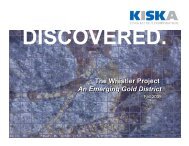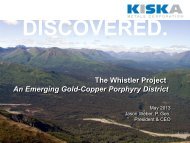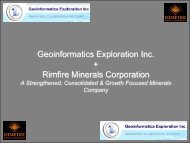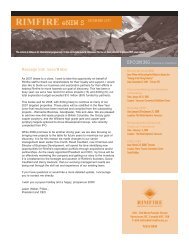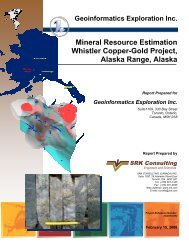view FS - Kiska Metals Corporation
view FS - Kiska Metals Corporation
view FS - Kiska Metals Corporation
Create successful ePaper yourself
Turn your PDF publications into a flip-book with our unique Google optimized e-Paper software.
<strong>Kiska</strong> <strong>Metals</strong> <strong>Corporation</strong><br />
Notes to the consolidated interim financial statements<br />
March 31, 2012 and 2011<br />
(Expressed in Canadian Dollars)<br />
(Unaudited – Prepared by Management)<br />
4. Summary of significant accounting policies (continued)<br />
Interest revenue<br />
For all financial instruments measured at amortized cost and interest bearing financial assets classified<br />
as available for sale, interest income or expense is recorded using the effective interest rate (EIR), which<br />
is the rate that exactly discounts the estimated future cash payments or receipts through the expected life<br />
of the financial instrument or a shorter period, where appropriate, to the net carrying amount of the<br />
financial asset or liability. Interest income is included in finance revenue in profit or loss.<br />
Share-based employee remuneration<br />
The Group operates equity-settled share-based remuneration plans for its employees. None of the<br />
Group's plans feature any options for a cash settlement.<br />
All goods and services received in exchange for the grant of any share-based payment are measured at<br />
their fair values. Where employees are rewarded using share-based payments, the fair values of<br />
employees' services are determined indirectly by reference to the fair value of the equity instruments<br />
granted. This fair value is measured at the grant date, using the Black-Scholes option pricing model, and<br />
excludes the impact of non-market vesting conditions (for example profitability and sales growth targets<br />
and performance conditions).<br />
All share-based remuneration is ultimately recognized as an expense in profit or loss with a<br />
corresponding credit to the 'share option reserve,' over the period during which the related share-based<br />
remuneration vests.<br />
If vesting periods or other vesting conditions apply, the expense is allocated over the vesting period,<br />
based on the best available estimate of the number of share options expected to vest. Non-market<br />
vesting conditions are included in assumptions about the number of options that are expected to become<br />
exercisable. Estimates are subsequently revised, if there is any indication that the number of share<br />
options expected to vest differs from previous estimates. Any cumulative adjustment prior to vesting is<br />
recognized in the current period. No adjustment is made to any expense recognized in prior periods if<br />
share options ultimately exercised are different to that estimated on vesting.<br />
Upon exercise of share options, the proceeds received net of any directly attributable transaction costs<br />
up to the nominal value of the shares issued and the related share-based compensation included in<br />
‘share option reserve’ are allocated to share capital.<br />
Share-based payments to non-employees<br />
When options to purchase shares are issued to non-employees in return for goods and services, the fair<br />
value of the options issued is recognized as an expense, with a corresponding increase in the ‘share<br />
option reserve’, in the period in which the goods or services are received or are expected to be received.<br />
Other share-based payments<br />
Shares issued as payment for the acquisition of mineral property interests are recorded at the trading<br />
value of the shares on a public exchange on the date they are issued.<br />
17



